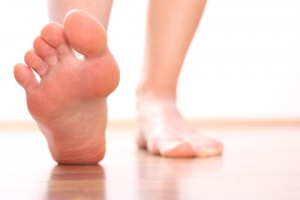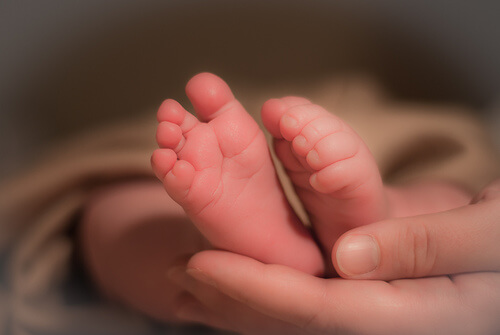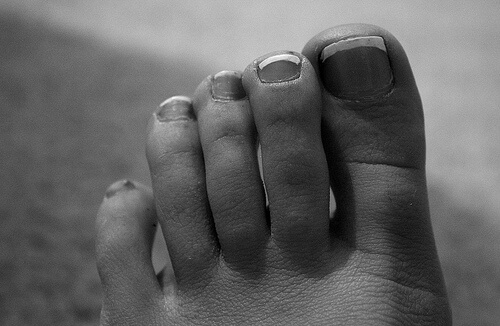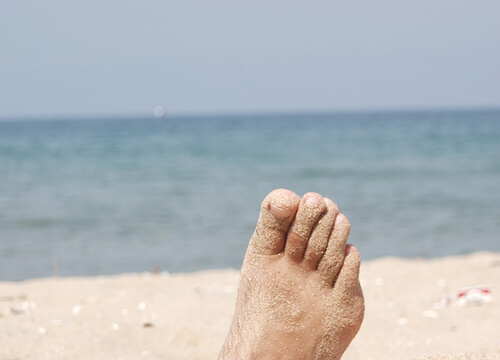The State of Your Health According to Foot Reflexology


Reviewed and approved by the doctor Gilberto Adaulfo Sánchez Abreu
Feet can reflect the state of health of our organs. Today we’ll look at how foot reflexology can attempt to explain the significance of different signs on our feet. These include temperature, color, calluses, bunions, and the shape of the toes.
In general terms, the toe region corresponds to the head, and that of the heel to the feet. Therefore, we can visualize approximately how the organs are located looking at the bottom of the foot.
When a part of the foot is hardened, it means that there may be an organ that is also hardened. These calluses also correspond to physical and mental rigidity in the reflex zone.
Foot reflexology and the spine reflex
The spine is believed to be reflected throughout the whole inner contour of the feet. For example, when a person suffers from bunions, that zone corresponds to the region of the upper back. You may, therefore, be suffering from some problem of the cervical vertebrae.
From this point of view, foot reflexology suggests that we do a massage along both interior lines of our feet. This, in turn, may positively affect the back.
Move the intestine
Foot reflexology says that intestinal reflex is located in the heel. Cracks or calluses on the heels may be a sign of intestinal problems. In this case, we can massage our heels. If they are quite tough then we can use a small ball to stand on.
The center of the foot
The central part of the foot corresponds to the entire digestive system: the liver, stomach, pancreas, and spleen. When we find rough patches in this area, it could point to stones in the kidney and the gall bladder.
The color of the feet
A yellow color always means the liver or gall bladder. On the other hand, a green hue corresponds to the spleen and lymphatic system. This sign is an opportunity to prevent. If you don’t pay attention to these signs, over time, toxins can accumulate and form cysts that may be harmful.
The toes reflect the head
The toes primarily reflect the upper part of the body, according to foot reflexology, with one exception. When there have already been gallstones for a while, our toes are generally very stiff, curved, and sore.
On the other hand, gallstones can also be present when the first toe is curved toward the second toe. In these cases, it would be good to cleanse the body, carefully watching the diet. The aim should be to flush out toxins, and take natural supplements.
Read more: 6 Foods to Help Fight Gallstones
Cold feet
When the feet and hands tend to be cold, there is a thermal imbalance in our body. The digestive system may be overworked with intestinal fever. In this case, we should improve our diet and therefore our intestinal function. We can also soak our feet in hot water and massage them with ginger oil to warm them.
Attacks of gout
We may find the base of the big toe and the ankle are red, swollen, and very painful. This could be caused by an attack of gout, an excess of uric acid in the body. The body tries to survive, so it tries to get rid of toxic substances from our vital organs. Because of this, the hands and feet show signs of some diseases.
Final note
This information confirms the benefits of walking barefoot in the sand on the beach. The same benefits are achieved through fresh grass, a river, wet soil etc. This activates our body, balances organ functions, and also is a great de-stressing therapy.
Read more: Understand the Negative Effects of Stress
We should also massage our feet, paying attention to any rough spots, painful areas, etc. Going to a foot reflexologist regularly will help us to prevent and heal diseases, starting with the feet. The treatment should last for at least a few months to get results.
Photography courtesy of M Robinson, HeyDanielle, and Rogiro
All cited sources were thoroughly reviewed by our team to ensure their quality, reliability, currency, and validity. The bibliography of this article was considered reliable and of academic or scientific accuracy.
- Wang, M. Y., Tsai, P. S., Lee, P. H., Chang, W. Y., & Yang, C. M. (2008). The efficacy of reflexology: Systematic review. Journal of Advanced Nursing. https://doi.org/10.1111/j.1365-2648.2008.04606.x
- Embong, N. H., Soh, Y. C., Ming, L. C., & Wong, T. W. (2015). Revisiting reflexology: Concept, evidence, current practice, and practitioner training. Journal of Traditional and Complementary Medicine. https://doi.org/10.1016/j.jtcme.2015.08.008
- Smith, C. A., Levett, K. M., Collins, C. T., Dahlen, H. G., Ee, C. C., & Suganuma, M. (2018). Massage, reflexology and other manual methods for pain management in labour. Cochrane Database of Systematic Reviews. https://doi.org/10.1002/14651858.CD009290.pub3
- J Tradit Complement Med. 2015 Oct; 5(4): 197–206. Published online 2015 Sep 28.Revisiting reflexology: Concept, evidence, current practice, and practitioner training. doi: 10.1016/j.jtcme.2015.08.008
This text is provided for informational purposes only and does not replace consultation with a professional. If in doubt, consult your specialist.










